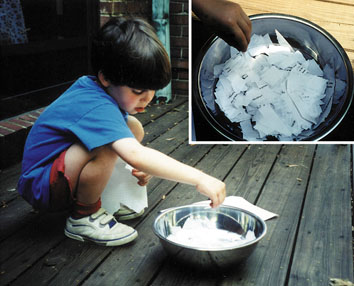

What do you use paper for? If you look around, probably every room where you live has several things made of paper—books, grocery lists, toilet paper, reports for school, this magazine. Since it was first invented by a Chinese man named Ts'ai Lun nearly 2000 years ago, paper has become a very important part of our lives.
But that has caused some problems. It takes about 17 big trees to make one ton of paper. It also takes a lot of water and electricity. What do you do with paper that you are finished with? Burning it causes air pollution, and throwing away that ton of paper takes up about 8 cubic feet in a landfill, which is bigger than some bathrooms.
One way to solve these problems is to use less paper. We can also recycle the paper we do use, because while most paper is made of wood, and Ts'ai Lun made his paper from hemp, rags and mulberry bark, paper can also be made out of paper.
You can understand how this works by making your own paper at home.
There are many different ways to make paper, but when we decided to try it, we wanted to use only materials we found around the house.
You will need:
1) a screen. You can use either a window screen that fits flat in your bathtub (ask for permission to use it) or you can make a screen by pulling a wire coathanger into a diamond shape, and pulling a nylon knee-high stocking over it. Pull the stocking up to where the wire is twisted together and wrap some tape around it to hold it there.
2) white glue
3) a food processor or blender
4) a bath towel (making paper can be really messy)
5) a bathtub or basin big enough to hold your screen
6) a big bowl
7) scrap paper such as used office paper (about 10 sheets) or newspaper (2 sheets)
First, tear your paper into small pieces, about an inch or so across. Put it in the big bowl with water, and let it soak for a long time. We let ours soak overnight.
Put about one third of the paper and about two cups of water in the food processor or blender and put the lid on tightly. You may need to ask for permission first. Wait! Don't turn it on yet! Remember the bath towel? Wrap it around the blender or processor, because the mixture will fly all over the place if you don't, and you will be picking off little bits of papery stuff for days. Now turn it on. When you have processed that paper into a gray mush, add more of the paper from the bowl, and more water if you need to, process, and then add the rest of the paper and process. Process for a long time. Maybe a couple of minutes. It needs to be really smooth.
Fill the tub you are using with about four inches of water, put the towel on the floor, and then dump the mush into the water. Add about one fourth of a cup of white glue. If you want to, you can add something to the water to make your paper look interesting. We added very small pieces of pink and purple construction paper, and some gold glitter. We also put in some lint from the dryer, just to see what would happen.
Stir the water around with your hand, and then take the screen and slide it down the side of the tub until it lies flat on the bottom. Hold it down there until the water stops moving, and then very, very slowly, holding it as straight as you can, bring it up through the water. We counted to twenty while we raised it, to make sure we did it slowly. Set it down on the towel.
What you have on your screen probably won't look much like paper yet. If everything worked, what you have now is a thin coating of wet pulp. Don't touch it or try to smooth it out—that will make a hole.
Now it needs to dry. If you used a coathanger screen, you can just hang it up somewhere. The window screen can lean against the bathroom wall or some other place where a few drips won't matter. Be sure you clean up the tub.
When the paper is completely dry, peel it off. It is pretty strong.
Does your paper look like the recycled paper you can buy for computer printers or notebooks? Commercial recyclers take the ink out of the paper they recycle with chemicals and filters, glaze it, and pass it through big rollers to make it smooth and even. But paper you make at home is beautiful. What can you use it for? Writing notes? Wrapping presents? We would love for you to write to Carnegie Magazine on paper you made yourself.
I obtained information on recycling and the environment from The Paper Exchange, Inc., in Pittsburgh, and from Hammermill Papers, a division of International Paper.
—Ellen S. Wilson
Contents |
Highlights |
Calendar |
Back Issues |
Museums |